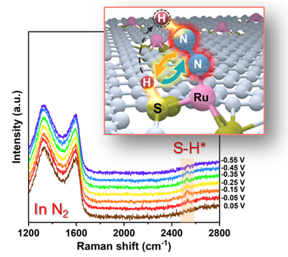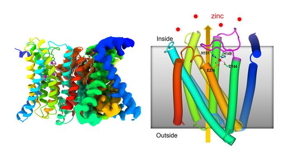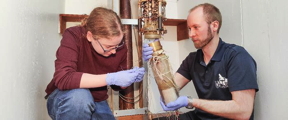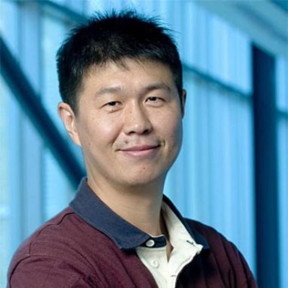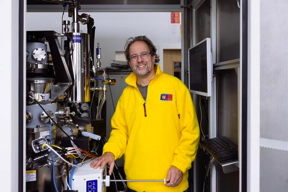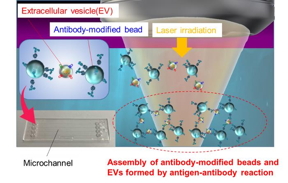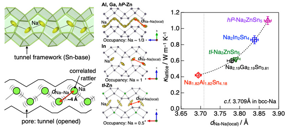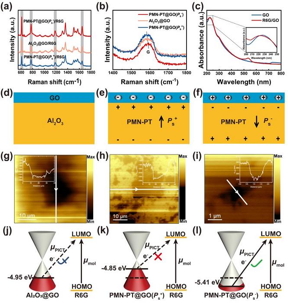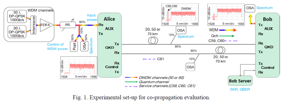Home > Press > New tools will help study quantum chemistry aboard the International Space Station: Rochester Professor Nicholas Bigelow helped develop experiments conducted at NASA’s Cold Atom Lab to probe the fundamental nature of the world around us
 |
Abstract:
At NASA’s Cold Atom Lab facility aboard the International Space Station, an international team of scientists produced a quantum gas containing two types of atoms for the first time in space. The achievement, outlined in a new study published in Nature, marks another step toward bringing quantum technologies currently available on Earth into space.
New tools will help study quantum chemistry aboard the International Space Station: Rochester Professor Nicholas Bigelow helped develop experiments conducted at NASA’s Cold Atom Lab to probe the fundamental nature of the world around us
Rochester, NY | Posted on November 17th, 2023
Through experiments controlled remotely on Earth, the researchers produced Bose-Einstein condensates—a quantum state of matter made from an atomic gas cooled to temperatures close to absolute zero. Nicholas Bigelow, the Lee A. DuBridge Professor of Physics and a professor of optics at the University of Rochester, says these quantum tools can be used to enhance the study of the essence of quantum matter, aid in the navigation between planets, as well as to help solve mysteries of the universe and deepen our understanding of the fundamental laws of nature.
Reaping the benefits of zero gravity
“There are a lot of things in fundamental physics where being in the presence of gravity actually limits how precise a measurement you can make,” says Bigelow, director of the NASA-funded Consortium for Ultracold Atoms in Space. “Removing gravity allows you to make a much longer observation time to get more precision in the measurement, and it allows you to see delicate effects that might be masked by gravity.”
With this new capability, the Cold Atom Lab can now study not only the quantum properties of individual atoms, but also quantum chemistry, which focuses on how different types of atoms interact and combine with each other in a quantum state. Researchers will be able to conduct a wider range of experiments with the Cold Atom Lab and learn more about the nuances of performing them in microgravity. That knowledge will be essential for harnessing the one-of-a-kind facility to develop new space-based quantum technologies.
One mystery the scientists aim to chip away at involves the equivalence principle, which holds that gravity affects all objects the same regardless of their mass. Part of Albert Einstein’s general theory of relativity—the backbone of modern gravitational physics—the principle doesn’t neatly match up with the laws of quantum physics, which describe behaviors of small objects like atoms. Scientists have already experimented with atom interferometers on Earth to see if the equivalence principle holds true at atomic scales, but they can test it more precisely in space at the Cold Atom Lab.
A route to understanding dark energy—and to better sensors and clocks
Bigelow says the scientists plan to run experiments using a two-atom interferometer and quantum gases to measure gravity with high precision to learn about the nature of dark energy, the mysterious driver behind the accelerating expansion of the universe. What they learn could lead to the development of precision sensors for a wide range of applications.
“We could make sensors that are extremely sensitive to small rotations and essentially use these cold atoms in the Bose-Einstein condensate to make gyroscopes,” says Bigelow. “These gyroscopes could give us a fixed reference point in space that could be used for deep space navigation. We’re also developing a number of things that could lead to better clocks in space, which are crucial to so many things in modern life such as high-speed internet and GPS.”
####
For more information, please click here
Contacts:
Luke Auburn
University of Rochester
Cell: 5854903198
Copyright © University of Rochester
If you have a comment, please Contact us.
Issuers of news releases, not 7th Wave, Inc. or Nanotechnology Now, are solely responsible for the accuracy of the content.
| Related Links |
| Related News Press |
Quantum Physics
![]() Three-pronged approach discerns qualities of quantum spin liquids November 17th, 2023
Three-pronged approach discerns qualities of quantum spin liquids November 17th, 2023
Quantum chemistry
![]() Three-pronged approach discerns qualities of quantum spin liquids November 17th, 2023
Three-pronged approach discerns qualities of quantum spin liquids November 17th, 2023
News and information
![]() Inverted perovskite solar cell breaks 25% efficiency record: Researchers improve cell efficiency using a combination of molecules to address different November 17th, 2023
Inverted perovskite solar cell breaks 25% efficiency record: Researchers improve cell efficiency using a combination of molecules to address different November 17th, 2023
![]() Night-time radiative warming using the atmosphere November 17th, 2023
Night-time radiative warming using the atmosphere November 17th, 2023
![]() A new kind of magnetism November 17th, 2023
A new kind of magnetism November 17th, 2023
Govt.-Legislation/Regulation/Funding/Policy
![]() Three-pronged approach discerns qualities of quantum spin liquids November 17th, 2023
Three-pronged approach discerns qualities of quantum spin liquids November 17th, 2023
![]() Inverted perovskite solar cell breaks 25% efficiency record: Researchers improve cell efficiency using a combination of molecules to address different November 17th, 2023
Inverted perovskite solar cell breaks 25% efficiency record: Researchers improve cell efficiency using a combination of molecules to address different November 17th, 2023
![]() Nanoparticle quasicrystal constructed with DNA: The breakthrough opens the way for designing and building more complex structures November 3rd, 2023
Nanoparticle quasicrystal constructed with DNA: The breakthrough opens the way for designing and building more complex structures November 3rd, 2023
Possible Futures
![]() Shedding light on unique conduction mechanisms in a new type of perovskite oxide November 17th, 2023
Shedding light on unique conduction mechanisms in a new type of perovskite oxide November 17th, 2023
![]() Silver nanoparticles: guaranteeing antimicrobial safe-tea November 17th, 2023
Silver nanoparticles: guaranteeing antimicrobial safe-tea November 17th, 2023
![]() Three-pronged approach discerns qualities of quantum spin liquids November 17th, 2023
Three-pronged approach discerns qualities of quantum spin liquids November 17th, 2023
![]() Inverted perovskite solar cell breaks 25% efficiency record: Researchers improve cell efficiency using a combination of molecules to address different November 17th, 2023
Inverted perovskite solar cell breaks 25% efficiency record: Researchers improve cell efficiency using a combination of molecules to address different November 17th, 2023
Sensors
![]() Electron collider on a chip June 30th, 2023
Electron collider on a chip June 30th, 2023
![]() Researchers discover materials exhibiting huge magnetoresistance June 9th, 2023
Researchers discover materials exhibiting huge magnetoresistance June 9th, 2023
![]() Laser direct writing of Ga2O3/liquid metal-based flexible humidity sensors May 12th, 2023
Laser direct writing of Ga2O3/liquid metal-based flexible humidity sensors May 12th, 2023
Discoveries
![]() Inverted perovskite solar cell breaks 25% efficiency record: Researchers improve cell efficiency using a combination of molecules to address different November 17th, 2023
Inverted perovskite solar cell breaks 25% efficiency record: Researchers improve cell efficiency using a combination of molecules to address different November 17th, 2023
![]() Night-time radiative warming using the atmosphere November 17th, 2023
Night-time radiative warming using the atmosphere November 17th, 2023
![]() A new kind of magnetism November 17th, 2023
A new kind of magnetism November 17th, 2023
Announcements
![]() Inverted perovskite solar cell breaks 25% efficiency record: Researchers improve cell efficiency using a combination of molecules to address different November 17th, 2023
Inverted perovskite solar cell breaks 25% efficiency record: Researchers improve cell efficiency using a combination of molecules to address different November 17th, 2023
![]() Night-time radiative warming using the atmosphere November 17th, 2023
Night-time radiative warming using the atmosphere November 17th, 2023
![]() A new kind of magnetism November 17th, 2023
A new kind of magnetism November 17th, 2023
Interviews/Book Reviews/Essays/Reports/Podcasts/Journals/White papers/Posters
![]() Inverted perovskite solar cell breaks 25% efficiency record: Researchers improve cell efficiency using a combination of molecules to address different November 17th, 2023
Inverted perovskite solar cell breaks 25% efficiency record: Researchers improve cell efficiency using a combination of molecules to address different November 17th, 2023
![]() Night-time radiative warming using the atmosphere November 17th, 2023
Night-time radiative warming using the atmosphere November 17th, 2023
![]() A new kind of magnetism November 17th, 2023
A new kind of magnetism November 17th, 2023
Aerospace/Space
![]() Manufacturing advances bring material back in vogue January 20th, 2023
Manufacturing advances bring material back in vogue January 20th, 2023
![]() The National Space Society Congratulates NASA on the Success of Artemis I Same-day Launch of the Hakuto-R Lunar Landing Mission will Help Support Future Lunar Crews December 12th, 2022
The National Space Society Congratulates NASA on the Success of Artemis I Same-day Launch of the Hakuto-R Lunar Landing Mission will Help Support Future Lunar Crews December 12th, 2022
![]() Surface microstructures of lunar soil returned by Chang’e-5 mission reveal an intermediate stage in space weathering process September 30th, 2022
Surface microstructures of lunar soil returned by Chang’e-5 mission reveal an intermediate stage in space weathering process September 30th, 2022
- SEO Powered Content & PR Distribution. Get Amplified Today.
- PlatoData.Network Vertical Generative Ai. Empower Yourself. Access Here.
- PlatoAiStream. Web3 Intelligence. Knowledge Amplified. Access Here.
- PlatoESG. Carbon, CleanTech, Energy, Environment, Solar, Waste Management. Access Here.
- PlatoHealth. Biotech and Clinical Trials Intelligence. Access Here.
- Source: http://www.nanotech-now.com/news.cgi?story_id=57418
- :not
- :where
- $UP
- 10
- 12th
- 17th
- 18th
- 20th
- 30th
- 3rd
- 7th
- 9th
- a
- Able
- About
- Absolute
- accelerating
- accuracy
- achievement
- actually
- address
- advances
- affects
- Aid
- aim
- All
- allows
- already
- also
- an
- and
- Another
- applications
- approach
- ARE
- around
- Artemis
- AS
- At
- atom
- available
- away
- back
- Backbone
- BE
- behaviors
- behind
- being
- benefits
- Better
- between
- boasts
- breaks
- breakthrough
- bring
- Bringing
- Building
- bulletproof
- but
- by
- CAN
- capability
- carbon
- cell
- Center
- CGI
- chemistry
- chip
- click
- Clocks
- Close
- cold
- COM
- combination
- combine
- comment
- complex
- Conduct
- conducted
- consortium
- content
- controlled
- could
- crucial
- Currently
- Dark
- December
- deep
- Deepen
- del
- describe
- designing
- develop
- developing
- Development
- different
- direct
- Director
- discover
- dna
- doesn
- Doesn’t
- driver
- each
- earth
- effects
- efficiency
- end
- energy
- enhance
- equivalence
- essence
- essential
- essentially
- Ether (ETH)
- Exhibiting
- expansion
- experiments
- extremely
- Facility
- films
- First
- first time
- fixed
- flexible
- focuses
- For
- from
- fundamental
- future
- futuristic
- GAS
- General
- get
- gif
- Give
- gps
- Graphene
- gravitational
- gravity
- greater
- Harnessing
- Have
- help
- helped
- High
- holds
- How
- http
- HTTPS
- huge
- i
- if
- improve
- in
- Inc.
- individual
- information
- interact
- Intermediate
- International
- international space station
- Internet
- into
- involves
- IT
- ITS
- January
- jpg
- june
- just
- Kind
- knowledge
- lab
- landing
- laser
- launch
- Laws
- lead
- LEARN
- Lee
- lenses
- Life
- light
- like
- limits
- links
- longer
- Lot
- Lunar
- made
- make
- many
- Mass
- Match
- material
- materials
- Matrix
- Matter
- May..
- measure
- measurement
- mechanisms
- might
- Mission
- Modern
- more
- much
- mysterious
- Mystery
- nanotechnology
- Nasa
- National
- Nature
- Navigation
- net
- New
- news
- nicholas
- November
- now
- nuances
- number
- NY
- objects
- observation
- of
- on
- One-of-a-Kind
- only
- opens
- optics
- or
- Other
- our
- outlined
- part
- performing
- PHP
- Physics
- plan
- Planets
- plato
- Plato Data Intelligence
- PlatoData
- please
- Point
- Post
- posted
- precise
- precisely
- Precision
- presence
- press
- Press Release
- principle
- probe
- Produced
- Professor
- properties
- published
- qualities
- Quantum
- quantum physics
- range
- record
- reference
- Regardless
- release
- Releases
- remotely
- Renowned
- researchers
- Resistance
- responsible
- return
- reveal
- Rival
- Route
- Run
- same
- Save
- says
- scales
- scientists
- Search
- see
- sensitive
- sensors
- September
- setup
- Share
- small
- So
- Society
- soil
- solar
- solely
- SOLVE
- Space
- space station
- space-based
- speed
- Spin
- Stage
- start
- State
- State of matter
- station
- Step
- strength
- strong
- structures
- Study
- submit
- success
- such
- support
- T
- team
- technique
- Technologies
- test
- Testing
- than
- that
- The
- the world
- their
- Them
- theory
- These
- they
- things
- this
- time
- times
- to
- tools
- toward
- true
- tunnel
- two
- type
- types
- Ultra
- understanding
- unique
- Universe
- university
- us
- use
- used
- using
- Wave
- Way..
- WELL
- What
- which
- wide
- Wide range
- wider
- will
- wind
- with
- world
- writing
- Yahoo
- Yield
- you
- zephyrnet
- zero










